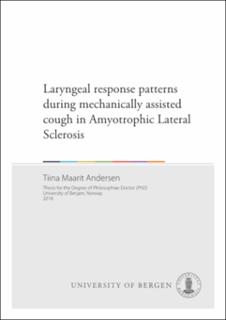Laryngeal response patterns during mechanically assisted cough in Amyotrophic Lateral Sclerosis
Doctoral thesis
Permanent lenke
https://hdl.handle.net/1956/17868Utgivelsesdato
2018-06-21Metadata
Vis full innførselSamlinger
Sammendrag
Background: Patients with amyotrophic lateral sclerosis (ALS) are treated with mechanical cough assist devices using the technique of mechanical insufflationexsufflation (MI-E) in order to improve cough and enhance clearance of airway secretions. The aim of treatment is to prevent lung infections and to provide a better quality of life. The technique often fails in ALS patients with bulbar involvement, allegedly due to upper airway malfunction. Laryngeal collapse during exsufflation has been proposed to explain the ineffectiveness of MI-E in bulbar ALS. However, there are a lack of studies utilizing comprehensive and verifiable methods to investigate the role played by the larynx of patients in whom MI-E appears to be nonsuccessful. Objectives: Study #I: To examine the feasibility of transnasal fiberoptic laryngoscopy (TFL) during ongoing MI-E in healthy volunteers, and to describe normal laryngeal response pattern(s) to MI-E. Study #II: To investigate laryngeal response patterns to MI-E in a cross-sectional study of ALS of different phenotypes. Study #III: To examine and describe changes in laryngeal response patterns to MI-E as ALS progresses, and to explore if treatment protocols can possibly be modified and improved in these patients. Design: Population-based, explorative, descriptive, observational studies, with crosssectional design in Study #I and #II, and prospective cohort design in the Study #III. Subjects: Study #I: Twenty healthy medical students. Study #II: Twenty patients with ALS together with 20 healthy volunteers, matched for age and gender. Study #III: Thirteen eligible patients with ALS, recruited from Study II, prospectively followed during disease progression for up to 5 years. Methods: ALS was phenotyped according to established international standards. Upper and lower motor neuron symptoms were characterized, and the respiratory function determined. Video recorded flexible TFL was applied during ongoing cough assisted by MI-E that was applied using various pressures according to a preset protocol. The video files were used to carefully assess and tabulate the laryngeal movements. The examinations were performed at outpatient visits that were scheduled at set time-intervals. Results: Study #I: The larynx could be studied with TFL during ongoing MI-E. The laryngeal responses to MI-E in healthy volunteers were compatible to that described in normal cough. Study #II: The laryngeal structures of patients with ALS and bulbar symptoms tended to adduct, especially during insufflation, which in some patients severely compromised the size of the laryngeal inlet, especially if high pressures were applied. Study #III: During ALS disease progression, the first signs of laryngeal adduction occurred with the highest insufflation pressures and prior to any clinically evident signs of bulbar involvement. Hypopharyngeal constriction during exsufflation was observed in all subjects regardless of bulbar symptoms, and later in the disease progression than the above described adverse events during insufflation. Cough gradually became less expulsive and also less synchronized at the laryngeal level. Triggering of swallowing reflexes by the positive air flow from the MI-E further complicated these matters. Attempts of careful individual tailoring of the MI-E therapy as the patients’ condition deteriorated seemed to prolong its successful use. Conclusions and interpretations: Laryngoscopy can safely be performed during ongoing MI-E, and appears a feasible tool to visualize the laryngeal responses to this therapy. In bulbar ALS, laryngeal structures are prone to adduct throughout the various pressure cycles of MI-E, especially if applying high insufflation pressures, thereby severely obstructing the airflow and thus hampering the effect of the treatment. Cough patterns alter as ALS progresses, and rapidly alternating MI-E pressure cycles may become challenging or even impossible to handle for patients. Individually tailored MI-E treatment can improve and may possible extend the use of non-invasive ventilatory support in ALS, and TFL can become a feasible and valuable tool in this respect.
Består av
Paper I: Laryngeal Response Patterns to Mechanical Insufflation-Exsufflation in Healthy Subjects. Andersen T, Sandnes A, Hilland M, Halvorsen T, Fondenes O, Heimdal J-H, Tysnes O-B and Røksund OD. Am J Phys Med Rehabil 2013 Vol. 92: 920-9. The article is not available in BORA due to publisher restrictions. The published version is available at: https://doi.org/10.1097/phm.0b013e3182a4708fPaper II: Laryngeal response patterns influence the efficacy of mechanical assisted cough in amyotrophic lateral sclerosis. Andersen T, Sandnes A, Brekka AK, Hilland M, Clemm H, Fondenes O, Tysnes O-B, Heimdal J-H, Halvorsen T, Vollsæter M and Røksund OD. Thorax 2017 Mar; 72(3):221-229. The article is available at: http://hdl.handle.net/1956/15356
Paper III: Laryngeal Responses to Mechanically Assisted Cough in Progressing Amyotrophic Lateral Sclerosis. Andersen T, Sandnes A, Fondenes O, Miodini Nilsen R, Tysnes O-B, Heimdal J-H, Clemm H, Halvorsen T, Vollsæter M and Røksund OD. Respiratory Care, in press. The article is not available in BORA due to publisher restrictions. The published version is available at: https://doi.org/10.4187/respcare.05924
